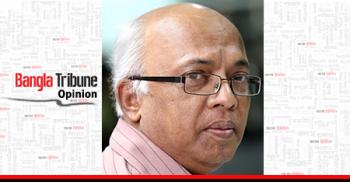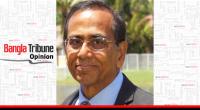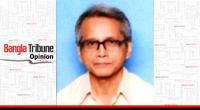 By the time March 25, 1971 arrived, all hopes for a political solution to the crisis in Pakistan had all but vanished. A day earlier, on March 24, sensing the sinister intentions of the Yahya Khan junta, Bangabandhu Sheikh Mujibur Rahman instructed his aides to propose to the regime that a wholesale transformation now needed to be brought into the concept of the state of Pakistan. The country would no more be a federation, but would or could be reconfigured as a confederation.
By the time March 25, 1971 arrived, all hopes for a political solution to the crisis in Pakistan had all but vanished. A day earlier, on March 24, sensing the sinister intentions of the Yahya Khan junta, Bangabandhu Sheikh Mujibur Rahman instructed his aides to propose to the regime that a wholesale transformation now needed to be brought into the concept of the state of Pakistan. The country would no more be a federation, but would or could be reconfigured as a confederation.
The message was duly conveyed to the junta. Lt Gen SGMM Peerzada, a leading member of the junta, promised to get back to the Awami League the next morning. Dr. Kamal Hossain and other leaders of the Awami League waited all day on March 25 for the call. The call did not come, of course, even though the Awami League had not quite given up hope about a proclamation being issued by President Yahya Khan on the modalities of a transfer of power.
Things were quite different in the military establishment, though. Having received the green signal from Yahya Khan, General Tikka Khan phoned General Khadem Husain Raja and told him: ‘Khadem, it is tonight.’That was the first sign of an impending military assault on Bengalis.
Through the afternoon and evening, Pakistani army officers helicoptered across the province, to spread the word among the various army formations that they had to be on standby for military operations to get underway. A number of West Pakistani political leaders visited Bangabandhu at his residence in Dhanmondi to bid him a sad farewell. Among them were Mir Ghaus Bux Bizenjo and Khan Abdul Wali Khan.
Sometime after dusk, General Yahya Khan, in stealthy manner and without officially bringing the on-going negotiations to an end, boarded at Tejgaon airport a Pakistan International Airlines flight for Karachi.
The orders were that the military assault, codenamed ‘Operation Searchlight’, would not begin until his aircraft had safely landed in Karachi. By 10 pm, it had become clear to Bangabandhu that an armed assault on citizens was on the way. He exhorted the senior leaders of his party to move to safety.
Even so, when Kamal Hossain met him around 10 pm, he asked him if there had been any phone call from the regime. Hossain replied in the negative before leaving Bangabandhu’s residence. Tajuddin Ahmad tried persuading Bangabandhu to leave the city along with other party leaders. For his part, Bangabandhu instructed him and the others to find safe sanctuary while he waited for the army to come for him.
Rumours of an imminent strike by the army led students of Dhaka University and citizens in general into putting up barricades in different parts of the city to thwart movements by the soldiers. No one, at that point, could visualise the scale of the ferocity with which the army planned to strike.
The Pakistan army pounced on the people of Bangladesh between 11 and 11.30 pm. Different units of the army fanned out in various directions. Tanks, armoured cars and trucks loaded with soldiers headed for Dhaka University, the Shaheed Minar, the Race Course (where the Kali Mandir was situated), Bangabandhu’s residence on Road 32 Dhanmondi, Hotel Intercontinental and Old Dhaka.
 Tracer fire lit up the night sky, with guns roaring all across town. The army moved to remove all foreign journalists from the Intercontinental and put them on flights out of the province. And then began the long night of killing — of academics, students, Bengali police personnel, as well as members of the East Pakistan Rifles, rickshaw pullers and citizens in general.
Tracer fire lit up the night sky, with guns roaring all across town. The army moved to remove all foreign journalists from the Intercontinental and put them on flights out of the province. And then began the long night of killing — of academics, students, Bengali police personnel, as well as members of the East Pakistan Rifles, rickshaw pullers and citizens in general.
The Shaheed Minar, long the symbol of Bengali nationalism, was reduced to rubble. The Kali Mandir suffered a similar fate. At Jagannath Hall and other halls of Dhaka University, soldiers stormed into the rooms and dormitories and murdered hundreds of students.
They killed Professor Gobinda Chandra Dev of the Department of Philosophy and Professor Rafiqul Islam of Mathematics. They grievously wounded Professor Jyotirmoy Guhathakurta of the Department of English. Guhathakurta was to die of his wounds a few days later.
Hundreds of students were murdered and buried in mass graves in the DU campus. An academic, Professor Nurul Ula, spent an entire night recording, from within the safe confines of his quarters in the university area, the shooting of students by the soldiers.
Zulfikar Ali Bhutto, chairman of the Pakistan People’s Party, watched Dhaka burn from his suite in the Intercontinental Hotel.
Senior leaders of the Awami League, including Syed Nazrul Islam, Tajuddin Ahmad, M Mansoor Ali and AHM Quamruzzaman made their way out of Dhaka in line with Bangabandhu’s instructions. For his part, as the hour struck midnight, Bangabandhu made a declaration of Bangladesh’s independence, which message was passed on to Chittagong Awami League leader MA Hannan on wireless.
Soon after he had declared Bangladesh a free nation, Bangabandhu was taken into custody by the Pakistan army. Over the next few days, he would be kept at Adamjee Cantonment College before being flown to West Pakistan.
Throughout the night between March 25 and March 26, the Pakistan army killed Bengalis. All day long on March 26, the killings went on.
The genocide would go on for nine months, leaving three million Bengalis dead, 200,000-plus Bengali women raped by Pakistan’s soldiers and countless villages and towns destroyed.
Syed Badrul Ahsan is the editor in charge at the Asian Age.


